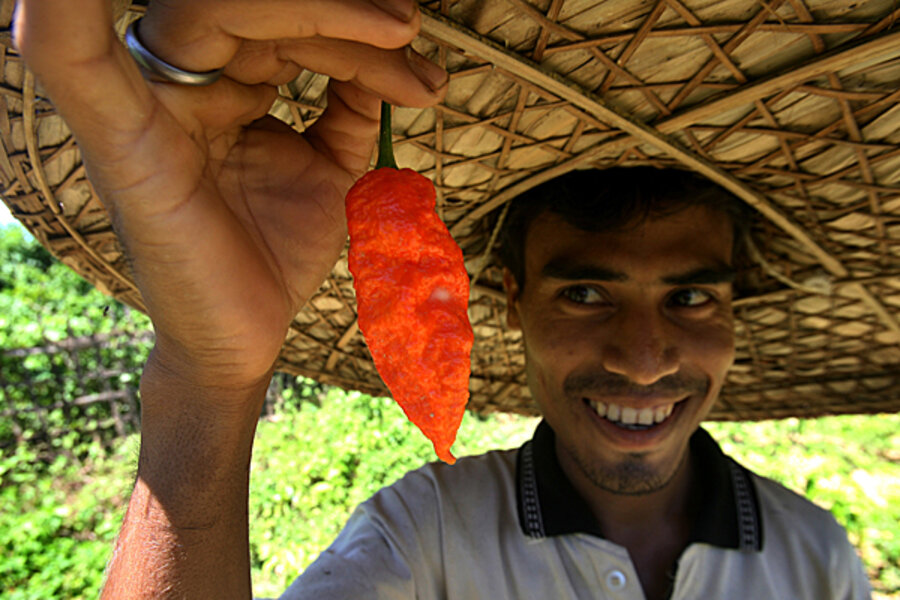India adds world's hottest chili pepper to its anti-terrorism arsenal
| Navi Mumbai, India
For about $10, Ravi Arora will sell you a pound of the Indian military's latest biological weapon in its anti-terrorism arsenal.
"No, no, no. We recommend not to try them," Mr. Arora says when asked how he suggests using them, speaking at his office in a massive wholesale spice, bean, coconut, and dried-fruit market in Navi Mumbai, Mumbai's sister city. "Before exporting these chilies we have also informed my clients not to taste them.... It is killing."
That potency is just why the Indian military said last week that it would use the bhut jolokia, or "ghost chili,” which holds the Guinness World Record for hottest spice, to make tear gas hand grenades in the fight against terrorism. The nontoxic weapon can be used to choke terrorists or force them out of their hideouts, defense officials explained.
A good bhut jolokia measures just over 1,000,000 Scoville units, the scientific measure of hotness. (Regular Tabasco sauce, by comparison, sits between a mere 2,500 and 5,000 Scoville units; Habañero sauce registers at a little more than 7,000.)
Handle with gloves
At a glance the deep-maroon dried chilies, the size of a thumb, might be mistaken for a pile of prunes. They grow in India's northeast, where Arora says farmers have toughened hands from touching them. Last year a mother in the northeastern state of Assam ate 51 of the chilies in two minutes in front of visiting British chef Gordon Ramsay, possibly setting a world record. The fiery celebrity chef nibbled on one before begging for water.
Arora's employees use gloves and mask their noses when handling the recently recruited weapon.
Chili broker Ashit Mehta, whom Arora calls the "Chili Kingpin of India," is adamant that the Indian military needs to do testing on the aftereffects of the bhut jolokia grenade. He says traditional tear gases "only have this eye burning sensation," but with bhut jolokia, they will burn the skin as well.
"People should not get burned," Mr. Mehta says, taking questions between a series of cellphone calls on chili deals in Dubai. "Normal people will have a lot of problems."
It is called a ghost chili, Mehta adds, because "even the ghosts will not eat it."
"It is much more potent than normal tear gas," says a spokesman for the Indian Defence Research and Development Organisation, who asked not to be named. It gives the sensation of choking, respiratory distress, and eye irritation, he says, adding that the effects are temporary and the sufferer eventually recovers.
Taste test, with emergency yogurt on hand
Arora, the CEO of the spice exporter S.R. International, reluctantly gave this correspondent a small bag of the ghost chilies to take home. “Don’t risk it,” he said quietly.
The gentler, dried ones smelled like pepperoni, but left a faint tickle in the nose after a whiff. With a cup of cool yogurt, mint gum, and a friend on watch nearby, I touched the dry skin to my tongue, which immediately felt like fire ants were scurrying across it.
Two small touches to just my tongue and a nibble later, my upper lip suddenly seemed to be pressed down against a hotplate. I began to lose feeling in my nose. I understood why Mehta had said this pepper was an unfair weapon. (He also said this year's crop was much weaker than usual.)
Whether from fear or the weapon itself, I sweated for half an hour afterward.
Arora and Mehta say they primarily export the bhut jolokia to East Asia, where they're used for medicinal purposes. Buyers in the US have cropped up, too, Mehta says. "I don't know what they are using it for."





